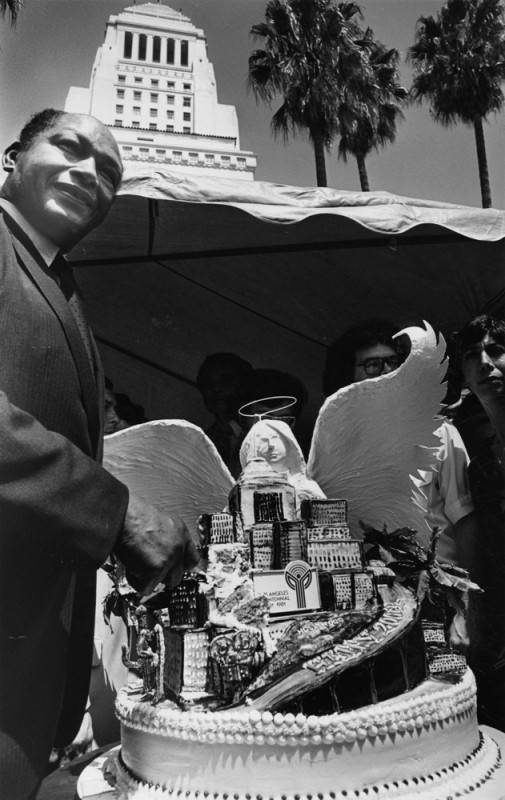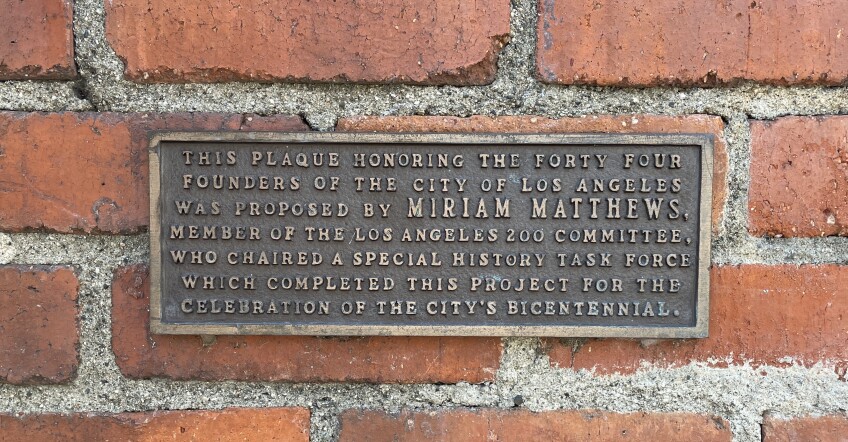These Two Women Spent Decades Highlighting the African Heritage of L.A.

On the 200th birthday of Los Angeles on September 4, 1981, Angelenos crowded in front of the steps of City Hall to witness a celebrity-filled bash. Mayor Tom Bradley cut the ornately-decorated birthday cake alongside actress Bernadette Peters. Actors Edward James Olmos, LeVar Burton, Brock Peters and Jean Stapleton read historical texts. On that day, a plaque that listed the 44 men, women and children who settled El Pueblo de Nuestra Señora La Reina de Los Ángeles in 1781 was dedicated. While many were just enjoying the bicentennial fanfare, for librarian Miriam Matthews it was an especially significant event because on that day, a piece of history was unveiled: a plaque with the mixed heritage of L.A.'s founding families.
When librarian Miriam Matthews joined the Bicentennial Commission (called L.A. 200 Committee) in the late 1970s, her top priority was the creation of a proper founders monument that acknowledged the pueblo's founding families with a list of their names, age and ethnic heritage. In her oral history, Matthews explained that her reasons for prioritizing such a project was due to the previous small founders plaque near Olvera Street with two sentences that weren't "well-phrased." She complained it "could have said they were of mixed Indian, Negro and Spanish blood [or] at least gotten something in there to indicate that they were not all Spaniards."

As chair of the commission's L.A. History Committee, Matthews kept close tabs on the progress of that founders monument by taking trips to the foundry, where the plaque was being designed, while leading committee discussions about the plaque's language. When lack of funding threatened the monument, she followed up numerous times with City Council and the bicentennial's executive office to inquire about the sudden lack of funds. She even offered to pay part of the foundry's fee though, fortunately, that was not necessary. The plaque was dedicated on September 4, 1981 at City Hall and installed at El Pueblo with a full list of the 44 men, women and children who settled in the pueblo along with their name, age, gender and ethnicity.

Matthews was not alone in her quest to remind Angelenos about the African heritage of the city's founding families. Alongside her was newspaper publisher and editor Charlotta Bass. While there is an increasing awareness about the African heritage of Los Angeles's first settlers, this is a look at a few of the ways in which Miriam Matthews and Chalotta Bass countered the whitewashing of Los Angeles history throughout the last century.
Shortly after Charlotta Bass arrived in Los Angeles in 1910, the newcomer was hired by John Neimore, publisher of the California Eagle. When he died in 1912, she took over the California Eagle (per Neimore's wishes) and grew it into a prominent platform for advocating against many social injustices, which included (but not limited to) hiring practices, segregated facilities, police brutality and racial covenants. She condemned city officials for their handling of the Zoot Riots and the mass incarceration of young Mexican American men. She spoke out in her newspaper against the forced relocation of Japanese Americans into concentration camps. She submitted testimony to the City Council and was active in California politics. She sold the paper in 1951 and by 1952, Bass became the first African American woman to run for Vice President.
Black history was a reoccurring theme in Bass's newspaper and that included reminders about the African heritage of Los Angeles's founding families. In 1941, Bass wrote "Of the eleven founding families, 56% would be classified as colored today! …These are no idle statistics, since the names, lot numbers and race of the founders are preserved in the archives of the State of California and City of Los Angeles." In 1948, she opined about the city's 167th anniversary, "When celebrating anniversaries, the City of Angels has always avoided any mention of the fact that among the first settlers (the first 44 persons) there were some important Black angels …"

In 1960, Bass self-published "Forty Years a Newspaper Women," part memoir, part "a record of the struggles, the heartaches and successes of our pioneers in this great city" (as she explained in her foreword). Bass again included stories about those first settlers with African heritage and provided hand-drawn maps of the original settlement and the route taken by the settlers in 1781.
She also published examples of the ways in which the city's founders had been whitewashed. She recounted how the Los Angeles school district published new textbooks in 1951 that removed the 1946 information about the ethnic composition of those families. Not only did the textbook, according to Bass, omit the African heritage but printed illustrations of the 44 founders in which "all are represented as white; and since there is no reference whatsoever to the Negro contribution to the founding of the city, the impression the students get is that Los Angeles was founded by white settlers." She chided W.W. Robinson's 1959 book "Los Angeles from the Days of the Pueblo" for "following the usual pattern adopted for the past 50 years by most white historians" for not mentioning that the majority of these founders had African heritage.

Charlotta Bass was 31 years older than Miriam Matthews but the two were both kindred spirits in their passion for documenting and sharing California's African American past. Miriam Matthews was mentioned often in the California Eagle as the paper reported on Matthew's women's club activities, library events and art exhibits. She even had a column titled "Book Notes" and occasionally penned articles about Black history in California.
Considered the "Dean of Los Angeles Black History," Miriam Matthews was born in 1905 and came to Los Angeles with her family when she was two years old. Best known as the first African American in California to become a certified librarian, Matthews was also the first African American to work the Los Angeles Public Library. She was a popular librarian who rose through the ranks, managing her first branch library in 1929. Around the same time, she was among the first to advocate for the establishment of Negro History Week. In her 2021 dissertation about Matthews, UCLA Library's Claudia Maureen Horning explained, "While she was at the Vernon Branch Library in the 1930s, Matthews noticed a growing interest in African American history, literature and race relations, and made a special effort to build the Vernon collection in these areas, often through personal donations of material she purchased with her own money."
In doing this work, she developed an extensive bibliography about California African American history and created and annotated a bibliography titled "The Negro in California 1781–1910" in 1944. She consulted not only local institutions like the Huntington Library and Dawson's Rare Book Shop, but also the Berkeley's Bancroft Library and the New York Public Library's Schomburg Collection (now the Schomburg Center for Research in Black Culture). As she explained in the bibliography's introduction, "When the Pueblo de Los Angeles was founded in 1781, almost fifty percent of the adult population and over seventy percent of the children were of Negro descent…There is a strong possibility that the blood of some of these early Negro settlers flows in the veins of some individuals belonging to the 'old families' of Los Angeles."
Matthews held book clubs, gave lectures and taught community classes related to the topic of "The Negro and the West." In 1948, Matthews was one of two historians who provided research and historical guidance for artists Charles Alston and Hale Woodruff's Golden State Mutual murals titled "The Negro in California History."

After she retired from the Los Angeles Public Library in 1960, Matthews continued her work in documenting and preserving local history, especially as it related to African Americans. In a 1975 article in the Los Angeles Sentinel, Matthews opined "It is a sad commentary when the names of these black families — Antonio Mesa, Manuel Camero, Luis Quintero, Jose Moreno — were omitted from many history books." After decades of collecting, Matthews' photos of African American history (archived at UCLA Library) were used for historical exhibits especially during Los Angeles's bicentennial in 1981. As for that El Pueblo founders monument dedicated in 1981, a smaller plaque was added and placed just under the larger one that reads, "This plaque honoring the forty four founders of the City of Los Angeles was proposed by Miriam Matthews, member of the Los Angeles 200 Committee…"

As the Mayor's Civic Memory Working Group debates the future of Los Angeles's civic monuments, this El Pueblo plaque represented an important step in publicly acknowledging the diverse ethnic heritage of the settlers who settled the pueblo. Though, when discussing the founding of Los Angeles, one needs to acknowledge the critical fact that these settlers arrived on land that for thousands of years had been occupied by the Tongva, a number of whom had dealt with European explorers and traders. As David Rough-Torres articulated, "Drawn into the orbit of Spain's North American colonial enterprise when explorers visited California in the 1500s, Tongva groups had been living in a world shaped by colonialism for more than two centuries."
In her book "The Power of Place," Dolores Hayden explained that "Los Angeles's population has always been diverse, from the day that the Gabrieleño Indians watched 44 settlers of mixed Spanish, Native American and African heritage found a new pueblo near the Gabrieleño village of Yang-Na in 1781." Yet much of that ethnic heritage had been whitewashed for the past two centuries as city boosters promoted the city's "Spanish fantasy past." Nowadays, there are many history-minded Angelenos who know about the diverse heritage of the city's founding families. But throughout the last century, two prominent African American women were among those consistently shining a light on the city's early African heritage — Charlotta Bass and Miriam Matthews.

Sources
Claudia Maureen Horning, “Trailblazing Librarian in the Golden State: A Look at the Life and Career of Miriam Matthews” (Dissertation, UCLA, 2012), last accessed August 18, 2021, https://escholarship.org/uc/item/8nx1v57d.
Miriam Matthews, interview by Robin D.G. Kelley, transcript, UCLA Library's Center for Oral History Research, Los Angeles, CA. https://oralhistory.library.ucla.edu/catalog/21198-zz00179s7c.
Charlotta Bass, Forty Years: Memoirs from the Pages of a Newspaper (Los Angeles: Self-Published, 1960).







